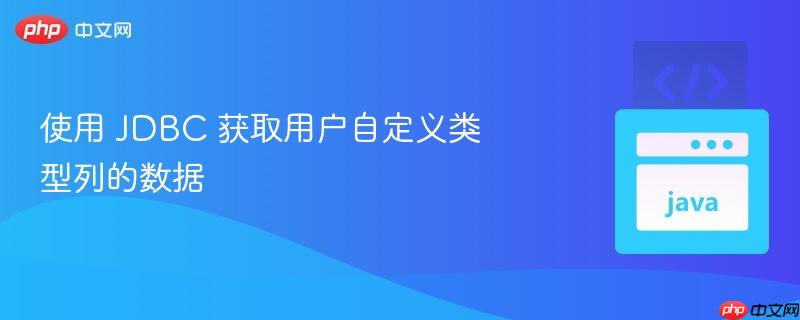
本文旨在指导开发者如何使用 JDBC API 从数据库中检索包含用户自定义数据类型列的数据。核心思路是将自定义数据类型序列化后存储到数据库,并在读取时反序列化。文章将提供序列化存储的方案,并给出相关的参考链接,帮助开发者理解和实现该过程。
当数据库表的某一列使用了用户自定义的数据类型时,直接使用 JDBC 的 ResultSet 接口获取数据可能会遇到困难。标准的 JDBC 方法可能无法直接识别和处理这些自定义类型。一种常见的解决方案是将自定义数据类型序列化后以二进制格式存储在数据库中,然后在读取数据时进行反序列化。
Java 提供了对象序列化的机制,可以将对象转换为字节流,方便存储和传输。以下是一个简单的序列化示例:
import java.io.*;
public class SerializationExample {
// 定义一个可序列化的类
public static class MyCustomType implements Serializable {
private String name;
private int value;
public MyCustomType(String name, int value) {
this.name = name;
this.value = value;
}
public String getName() {
return name;
}
public int getValue() {
return value;
}
@Override
public String toString() {
return "MyCustomType{" +
"name='" + name + '\'' +
", value=" + value +
'}';
}
}
public static void main(String[] args) {
MyCustomType obj = new MyCustomType("Example", 123);
// 序列化
try (FileOutputStream fileOut = new FileOutputStream("my_object.ser");
ObjectOutputStream out = new ObjectOutputStream(fileOut)) {
out.writeObject(obj);
System.out.println("Serialized data is saved in my_object.ser");
} catch (IOException i) {
i.printStackTrace();
}
// 反序列化
try (FileInputStream fileIn = new FileInputStream("my_object.ser");
ObjectInputStream in = new ObjectInputStream(fileIn)) {
MyCustomType deserializedObj = (MyCustomType) in.readObject();
System.out.println("Deserialized data: " + deserializedObj);
} catch (IOException i) {
i.printStackTrace();
} catch (ClassNotFoundException c) {
System.out.println("MyCustomType class not found");
c.printStackTrace();
}
}
}在这个例子中,MyCustomType 类实现了 Serializable 接口,这使得它可以被序列化和反序列化。通过 ObjectOutputStream 可以将对象写入文件,通过 ObjectInputStream 可以从文件中读取对象。
接下来,你需要将序列化后的字节流存储到数据库中。通常,可以使用 BLOB (Binary Large Object) 类型的列来存储这些数据。

本文档主要讲述的是mybatis语法和介绍;MyBatis 是一个可以自定义SQL、存储过程和高级映射的持久层框架。MyBatis 摒除了大部分的JDBC代码、手工设置参数和结果集重获。MyBatis 只使用简单的XML 和注解来配置和映射基本数据类型、Map 接口和POJO 到数据库记录。相对Hibernate和Apache OJB等“一站式”ORM解决方案而言,Mybatis 是一种“半自动化”的ORM实现。感兴趣的朋友可
 2
2

import java.sql.*;
import java.io.*;
public class DatabaseSerializationExample {
// 假设你已经有了数据库连接
public static void main(String[] args) {
String url = "jdbc:mysql://localhost:3306/mydatabase"; // 替换为你的数据库URL
String user = "myuser"; // 替换为你的数据库用户名
String password = "mypassword"; // 替换为你的数据库密码
try (Connection conn = DriverManager.getConnection(url, user, password)) {
// 准备要存储的对象
SerializationExample.MyCustomType obj = new SerializationExample.MyCustomType("Database Example", 456);
// 序列化对象
ByteArrayOutputStream bos = new ByteArrayOutputStream();
ObjectOutputStream oos = new ObjectOutputStream(bos);
oos.writeObject(obj);
byte[] serializedData = bos.toByteArray();
oos.close();
bos.close();
// 准备 SQL 语句
String sql = "INSERT INTO report (name, parameter) VALUES (?, ?)"; // 假设表名为 report,列名为 name 和 parameter
PreparedStatement pstmt = conn.prepareStatement(sql);
pstmt.setString(1, "ReportName");
pstmt.setBytes(2, serializedData); // 将序列化后的字节数组存入 BLOB 列
// 执行 SQL 语句
int rowsAffected = pstmt.executeUpdate();
System.out.println(rowsAffected + " rows inserted.");
pstmt.close();
} catch (SQLException | IOException e) {
e.printStackTrace();
}
}
}在这个例子中,我们首先将 MyCustomType 对象序列化为字节数组,然后使用 PreparedStatement 将数据插入到数据库的 report 表中。setBytes() 方法用于将字节数组设置到 BLOB 类型的列中。
从数据库中读取数据时,需要将 BLOB 列的数据读取出来,然后进行反序列化。
import java.sql.*;
import java.io.*;
public class DatabaseDeserializationExample {
public static void main(String[] args) {
String url = "jdbc:mysql://localhost:3306/mydatabase"; // 替换为你的数据库URL
String user = "myuser"; // 替换为你的数据库用户名
String password = "mypassword"; // 替换为你的数据库密码
try (Connection conn = DriverManager.getConnection(url, user, password)) {
// 准备 SQL 语句
String sql = "SELECT parameter FROM report WHERE name = ?"; // 假设表名为 report,列名为 name 和 parameter
PreparedStatement pstmt = conn.prepareStatement(sql);
pstmt.setString(1, "ReportName");
// 执行 SQL 语句
ResultSet rs = pstmt.executeQuery();
// 遍历结果集
while (rs.next()) {
// 获取 BLOB 数据
byte[] serializedData = rs.getBytes("parameter");
// 反序列化对象
ByteArrayInputStream bis = new ByteArrayInputStream(serializedData);
ObjectInputStream ois = new ObjectInputStream(bis);
SerializationExample.MyCustomType deserializedObj = (SerializationExample.MyCustomType) ois.readObject();
ois.close();
bis.close();
// 打印反序列化后的对象
System.out.println("Deserialized object: " + deserializedObj);
}
rs.close();
pstmt.close();
} catch (SQLException | IOException | ClassNotFoundException e) {
e.printStackTrace();
}
}
}在这个例子中,我们首先从数据库中读取 BLOB 列的数据,然后使用 ByteArrayInputStream 和 ObjectInputStream 将字节数组反序列化为 MyCustomType 对象。
通过将自定义数据类型序列化后存储到数据库,可以有效地解决 JDBC 无法直接处理自定义类型的问题。这种方法需要开发者手动处理序列化和反序列化的过程,并注意类版本兼容性、安全性和性能等方面的问题。掌握这种方法,可以更灵活地处理数据库中的复杂数据类型。
以上就是使用 JDBC 获取用户自定义类型列的数据的详细内容,更多请关注php中文网其它相关文章!

每个人都需要一台速度更快、更稳定的 PC。随着时间的推移,垃圾文件、旧注册表数据和不必要的后台进程会占用资源并降低性能。幸运的是,许多工具可以让 Windows 保持平稳运行。

Copyright 2014-2025 https://www.php.cn/ All Rights Reserved | php.cn | 湘ICP备2023035733号